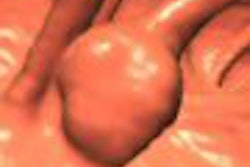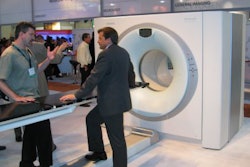SAN FRANCISCO - With an ever-increasing number of imaging and interventional procedures requiring the use of contrast media, contrast-induced nephropathy (CIN) is becoming a more critical issue for radiologists, cardiologists, and nephrologists.
At this week's International Symposium on Multidetector-Row CT in San Francisco, physicians debated the most appropriate steps to prevent CIN, which patients are most at-risk, and the efficacy of low- and iso-osmolar contrast media in reducing incidents of CIN.
Contrast-induced nephropathy is the sudden, rapid deterioration in renal function resulting from parental contrast medium administration. As more patients are exposed to contrast agents, the incidence of contrast nephropathy is likely to increase over the ensuing years and "remain a significant source of morbidity and mortality," said Dr. James A. Tumlin, director of the Southeast Renal Research Institute (SERRI) and associate professor of medicine at the University of North Carolina in Charlotte.
Tumlin cited studies that concluded that radiocontrast nephropathy (RCN) accounts for approximately one-third of all cases of acute renal failure among hospitalized patients, and that patients with "as little as a 25% rise in serum creatinine following contrast exposure have up to a 21% in-hospital mortality rate." In addition, the in-hospital mortality rate was as high as 37% for patients who become dialysis-dependent due to acute renal failure.
Risk factor screening
One key to CIN prevention is to accurately assess risk factors in each patient by monitoring serum creatinine and glomerular filtration rate (GFR). Tumlin noted that "virtually every report" on CIN lists abnormal baseline serum creatinine, low GFR, or underlying renal disease as potential risk factors.
"You simply cannot guess what the GFR is by eyeballing the serum creatinine," Tumlin added. "That's why we are recommending that the radiology community moves to using estimated GFR. There are different risk factors in different patients, so you have to make an estimate on everything."
Tumlin does not advocate screening every patient, but stressed the need for a process that can identify high-risk patients and adjust the protocol for the procedure appropriately. "Instead of making them the first case of the day to have an angiography done, have them done after lunch and appropriately hydrate them," he said.
Dr. Richard Solomon, professor of medicine at the University of Vermont and chief of the division of nephrology at Fletcher Allen Health Care in Burlington, VT, recommended that radiologists develop a questionnaire to identify high-risk patients through age, gender, medical history, instances of hypertension, diabetes, cardiovascular, or kidney disease. "In those individuals, I would get a serum creatinine (assessment), then calculate the GFR," he said. "If the GFR is under 60 (mls/min), I would identify (the patients) as high risk."
CIN in CT
Solomon added that radiologists don't always have an opportunity to recognize complications related to CIN, because most patients are imaged on an outpatient basis and leave the radiology suite after their exam, and clinicians don't always get to check serum creatinine.
For CT cases, he strongly advocated that all outpatients drink plenty of water the night before a contrast-enhanced CT procedure. "If you still have a protocol that says your patients should be NPO after midnight, I would ask you to abandon that (protocol) unless there is some very special reason why they shouldn't have any water," Solomon said. For abdominal CT contrast, he also recommended adequate hydration for patients who will receive contrast orally.
"If a CT scan is needed and there is a good clinical indication, I would use that as my guide and be cautious about hydrating and monitoring the patient," concurred Dr. Richard Katzberg, professor of radiology at the University of California Davis Medical Center in Davis. "I think there is a risk of contrast-induced nephrotoxicity, but hydration, having a good dialogue with the clinician, and following the patient after you give the contrast should overwhelm the theoretical risk of nephrotoxicity that could lead to a patient going into dialysis."
CIN study results
In his presentation on the validity of CIN, Katzberg maintained that the "great variation" in reported incidence is due to "a lack of consensus in definition, assessment with serum creatinine rather than creatinine clearance, differing patient populations, wide variability in doses, and route of administration, unstable baseline renal function, limited knowledge of the state of patient hydration, and other uncontrolled factors."
The findings, he said, are not supportive of clinically significant renal injury in the usual daily performance of contrast-enhanced multidetector CT. CIN "for intravenous use seems to be exaggerated for adverse medical outcomes, even in patient with renal insufficiency, and appears to be self-limited," Katzberg concluded.
In his talk, Solomon asserted that there is no difference in CIN when comparing low- and iso-osmolar contrast agents. While prospective randomized head-to-head comparisons of contrast agents are "the most scientific, rigorous way to identify potential differences in the incidence of CIN," he said they are "highly dependent on what they are compared to. The head-to-head comparison trials that have been performed do not provide consistent or compelling evidence for a difference between low- and iso-osmolar agents administered inter arterially or intravenously to high-risk patients."
By Wayne Forrest
AuntMinnie.com staff writer
June 15, 2006
Related Reading
Firm raises eyebrows with push to enforce antikidney-failure patent, June 13, 2006
GE investigates Omniscan cases, June 12, 2006
Part II: Palliative steps prevent contrast-induced nephropathy, September 20, 2005
Part I: Identifying patients at risk of contrast-induced nephropathy, September 13, 2005
N-acetylcysteine does not prevent contrast-induced nephropathy, June 7, 2005
Copyright © 2006 AuntMinnie.com




















